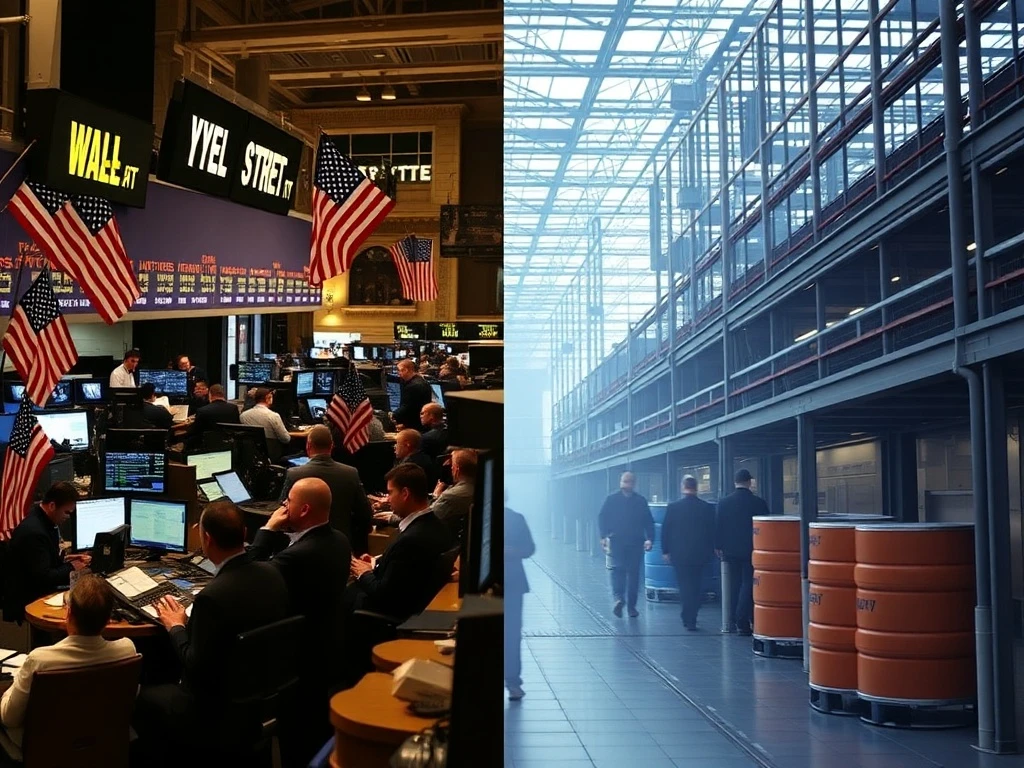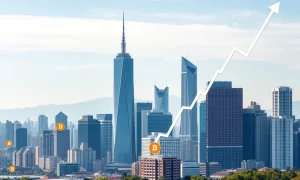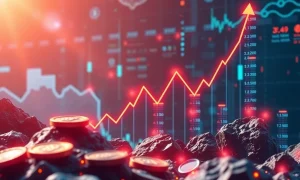Understanding the current state of the US economy presents a significant challenge. Financial markets, particularly Wall Street, often project an image of robust health and continuous growth. However, a closer look at underlying economic data reveals a more nuanced, and sometimes contradictory, picture. This divergence prompts crucial questions for investors, businesses, and everyday citizens alike. Is the optimism of financial markets truly reflective of the broader US economy, or are we witnessing a significant disconnect?
Unpacking Wall Street’s Optimism on the US Economy
Wall Street’s confidence in the US economy stems from several key factors. Corporate earnings, especially from large technology companies, have shown remarkable resilience. Furthermore, investor sentiment often reacts positively to expectations of future interest rate cuts by the Federal Reserve. This anticipation fuels market rallies. Consequently, strong stock market performance frequently creates a perception of overall economic strength. Many investors also believe the economy has successfully navigated inflationary pressures.
Key drivers behind Wall Street’s positive outlook include:
- Strong Corporate Earnings: Major companies report robust profits, boosting investor confidence.
- Anticipated Rate Cuts: Expectations of lower interest rates encourage borrowing and investment.
- Technological Innovation: Growth in the tech sector drives significant market gains.
- Resilient Consumer Spending (Selective): Certain segments of the economy continue to spend, supporting revenue.
Moreover, the market often looks forward, pricing in future expectations rather than current realities. Therefore, a positive market outlook might reflect anticipated improvements in the US economy months down the line. This forward-looking nature can sometimes obscure present-day challenges. Investors often interpret favorable macroeconomic headlines as signals of broader prosperity. This perspective, however, might not align with the daily experiences of many households and small businesses.
The Reality Check: What Economic Data Reveals about the US Economy
While Wall Street often paints a rosy picture, actual economic data presents a more complex narrative for the US economy. Various indicators, from inflation rates to consumer debt levels, suggest underlying pressures. These data points reflect the lived experiences of many Americans, contrasting sharply with market exuberance. Understanding these metrics provides a more grounded view of economic health. Therefore, a comprehensive analysis requires examining both market sentiment and hard data.
Decoding Inflation’s Impact on the US Economy
Inflation remains a persistent concern for the US economy. While the rate of price increases has cooled from its peak, it still remains above the Federal Reserve’s target. This sustained inflation erodes purchasing power for consumers. Higher prices for everyday goods and services, like groceries and housing, strain household budgets. The Consumer Price Index (CPI) and Personal Consumption Expenditures (PCE) index are crucial measures. Both indicate that while inflation moderates, it continues to affect financial stability. Consequently, many families face increased cost-of-living challenges.
Key inflation insights include:
- Sticky Services Inflation: Prices for services, such as healthcare and housing, remain elevated.
- Food and Energy Volatility: These sectors often experience rapid price fluctuations, impacting budgets.
- Wage-Price Spiral Concerns: Some economists worry about wages rising to match prices, creating a cycle.
Furthermore, persistent inflation can lead to higher interest rates. The Federal Reserve often raises rates to combat rising prices. These higher rates then affect borrowing costs for mortgages, car loans, and business investments. Ultimately, this can slow economic activity. Therefore, the battle against inflation significantly shapes the trajectory of the US economy. Policymakers constantly monitor these trends to make informed decisions.
Consumer Spending and Debt: A Closer Look at the US Economy’s Engine
Consumer spending drives a significant portion of the US economy. Recent data, however, indicates a mixed picture. While overall retail sales remain positive, the growth rate has slowed. Furthermore, consumers increasingly rely on credit to maintain their spending habits. Credit card debt has reached record highs. This reliance on debt suggests that consumers may be struggling to keep pace with inflation using their current incomes. Therefore, this trend raises questions about the sustainability of current spending levels.
Consider these consumer trends:
- Rising Credit Card Balances: Households accumulate more debt to cover expenses.
- Declining Savings Rates: Americans are saving less, drawing down pandemic-era savings.
- Discretionary Spending Cuts: Consumers reduce non-essential purchases as budgets tighten.
Moreover, delinquencies on certain types of loans, such as auto loans and credit cards, have begun to tick up. This indicates financial stress among a segment of the population. A healthy US economy typically features strong consumer balance sheets. However, the current debt levels suggest a potential vulnerability. This situation warrants close monitoring. A significant downturn in consumer confidence could quickly translate into reduced spending, impacting economic growth.
Labor Market Nuances: Beyond the Headlines for the US Economy
Job reports often highlight low unemployment rates, painting a picture of a robust labor market. However, a deeper dive reveals more complexity for the US economy. While job creation continues, wage growth has moderated. Many workers find their wages not keeping pace with inflation. This means their real purchasing power diminishes. Furthermore, the labor force participation rate has not fully recovered to pre-pandemic levels. This indicates some individuals remain outside the workforce.
Key aspects of the labor market:
- Job Openings vs. Hires: A mismatch exists between available jobs and actual hires in some sectors.
- Part-Time vs. Full-Time Employment: Some job growth occurs in part-time roles, which offer less stability.
- Sectoral Disparities: Certain industries experience significant job losses while others boom.
Moreover, the gig economy’s expansion complicates traditional employment metrics. Many individuals work multiple part-time jobs or contract roles to make ends meet. This can mask underlying underemployment. Therefore, while headline unemployment figures appear positive, they do not fully capture the challenges faced by many workers. A truly strong US economy requires not just jobs, but also quality jobs with competitive wages and benefits.
The Disconnect Explained: Why Perceptions Differ on the US Economy
The divergence between Wall Street’s optimism and economic data reflects fundamental differences in perspective and focus. Financial markets are forward-looking mechanisms. They discount future earnings and economic conditions into present asset prices. Conversely, economic data provides a snapshot of past and current realities. This temporal difference creates a natural gap. Investors focus on corporate profitability and growth potential. Meanwhile, data analysts examine broad indicators affecting households and small businesses. These distinct viewpoints contribute to differing conclusions about the US economy.
Several factors explain this disconnect:
- Forward-Looking vs. Lagging Indicators: Markets anticipate; data reflects.
- Sectoral Performance: Technology and large-cap stocks often drive market gains, not necessarily representing the entire economy.
- Monetary Policy Impact: Fed actions directly influence market liquidity and investor sentiment.
- Wealth Effect vs. Income Effect: Rising asset prices benefit a segment of the population, while inflation affects everyone.
Furthermore, the concentration of wealth plays a role. A significant portion of stock market gains benefits a relatively small percentage of the population. These individuals often have substantial financial assets. Therefore, their perceived economic well-being improves. However, the majority of households rely on wages and savings. They experience the effects of inflation and interest rate changes more directly. This disparity in economic experience fuels the different narratives about the US economy. Understanding these underlying mechanisms is crucial for a balanced view.
Navigating the Uncertain Path for the US Economy
The path forward for the US economy remains uncertain. Policymakers face the delicate task of managing inflation without triggering a recession. Meanwhile, businesses must adapt to evolving consumer behaviors and supply chain dynamics. Investors, consequently, must navigate volatile markets. The interplay of global events, domestic policies, and consumer confidence will shape the future trajectory. Therefore, vigilance and adaptability are paramount for all stakeholders. Predictions about the economy’s future often vary widely.
Potential scenarios for the US economy include:
- Soft Landing: Inflation cools without a significant economic downturn.
- Mild Recession: A brief period of economic contraction occurs as inflation is brought under control.
- Stagflation: Persistent inflation combined with slow economic growth and high unemployment.
- Continued Divergence: Markets remain strong while underlying economic data shows weakness.
Moreover, geopolitical tensions and unexpected events can significantly impact economic stability. Supply chain disruptions, energy price shocks, or new trade policies can quickly alter the outlook. Therefore, economic forecasts must remain flexible. Individuals and businesses should focus on financial resilience. Diversifying investments and maintaining emergency savings become even more important in uncertain times. The ultimate direction of the US economy will depend on a complex interplay of these factors.
In conclusion, the current state of the US economy presents a complex picture. Wall Street’s optimism, driven by corporate performance and monetary policy expectations, contrasts with the more challenging realities reflected in key economic data. Inflation, consumer debt, and nuanced labor market trends all paint a less rosy picture than market headlines often suggest. This divergence highlights the importance of looking beyond superficial indicators. A comprehensive understanding requires analyzing both financial market sentiment and fundamental economic statistics. Therefore, staying informed about a wide range of data points is crucial for grasping the true health of the US economy. The path ahead requires careful navigation, acknowledging both the strengths and vulnerabilities present within the economic landscape.
Frequently Asked Questions (FAQs) about the US Economy
Q1: Why does Wall Street seem more optimistic than economic data suggests?
Wall Street is primarily forward-looking, pricing in future earnings and anticipated monetary policy changes like interest rate cuts. Economic data, however, reflects current or past conditions, such as inflation rates and consumer spending habits. This difference in focus often creates a perception gap regarding the overall health of the US economy.
Q2: What are the key economic indicators that contradict Wall Street’s optimism?
Key indicators include persistent inflation (especially in services), rising consumer credit card debt, declining personal savings rates, and a nuanced labor market where wage growth often lags behind inflation. These factors suggest ongoing financial pressure for many households in the US economy.
Q3: How does inflation specifically impact the average American household?
Inflation erodes purchasing power, meaning that money buys less than it used to. This directly impacts household budgets through higher costs for essentials like groceries, housing, and transportation. Consequently, many families find it harder to save or maintain their standard of living, affecting the broader US economy.
Q4: What is the significance of consumer debt levels in assessing the US Economy?
High consumer debt levels, particularly credit card debt, can signal financial strain. While spending might continue, it often relies on borrowing rather than rising incomes. This reliance creates vulnerability, as higher interest rates make debt more expensive, potentially leading to reduced future spending and economic slowdown for the US economy.
Q5: What is a ‘soft landing’ for the US Economy?
A ‘soft landing’ refers to a scenario where the Federal Reserve successfully reduces inflation through interest rate hikes without causing a significant economic recession. It implies a slowdown in economic growth, but not a sharp contraction or widespread job losses. Achieving a soft landing is a challenging goal for policymakers managing the US economy.
























